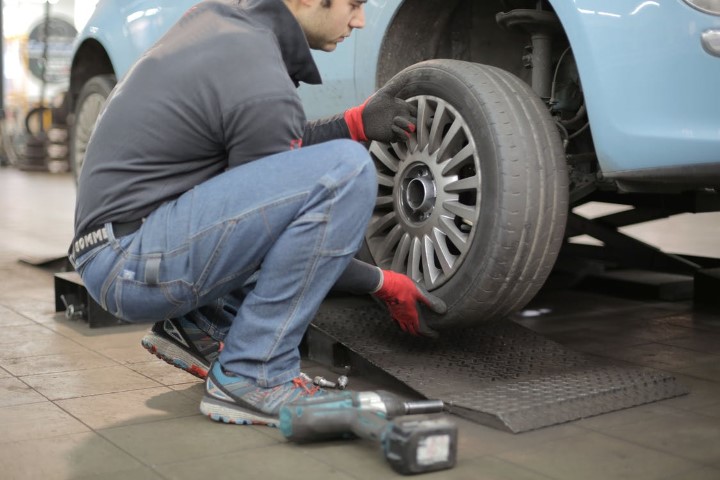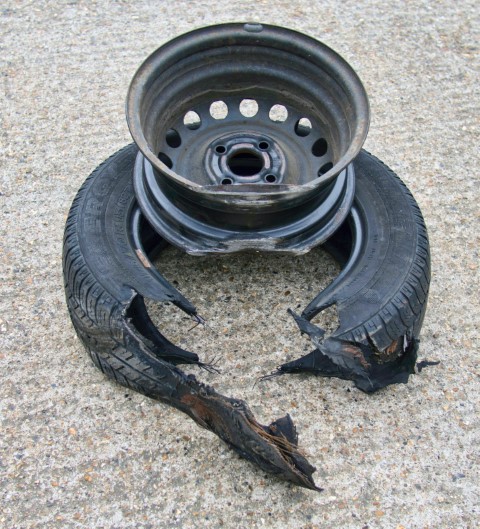 Suppose you are driving down the road when your tire suddenly blows out. Your car skids out of control and slams into something. What should you do in this case? Who is to blame here? Flat tires? Even though careless drivers are a major contributor to auto accidents, few people give tire maintenance the attention it deserves.
Suppose you are driving down the road when your tire suddenly blows out. Your car skids out of control and slams into something. What should you do in this case? Who is to blame here? Flat tires? Even though careless drivers are a major contributor to auto accidents, few people give tire maintenance the attention it deserves.
How much more likely is a car crash to occur, say, when a tire suddenly blows out or becomes flat? There are a wide variety of tire problems, from uneven wear to tread separation to improper inflation. A tire can be blown out by something as simple as a rise in temperature if the pressure inside builds to an unsafe level. These factors often contribute to vehicle accidents.
Here’s Why You Should Avoid Driving with a Flat Tire
If you have a flat tire while driving, the first few minutes after the problem occurs are crucial. For tires to be considered “flat,” they must have lost a significant amount of air pressure. Numerous factors, including manufacturing flaws, low air pressure, punctures, and excessive use, can contribute to this problem.
Some tires also have built-in defects, such as bumps or bulges on the sidewall. Do not drive on the tire. Have a professional tire mechanic look at it if you notice any of these signs. Surface cracks are another warning sign that your tire could blow out soon. There’s no need to risk driving on a tire with surface cracks, as this is a sure sign that it’s well past its expiration date.
If you don’t replace a tire when it’s time, it could burst, especially with older tires. It is recommended that tires with a tread depth of less than 2/32nds be replaced immediately and that tires with exposed steel belts never be driven again. Also, make sure your air pressure is at the right level by checking it frequently. The increased wear, damage, and heat generated by driving on under-inflated tires can cause a tire to fail before its time. Also, note that your tire pressures might need to be adjusted based on the weather.
A flat tire is much harder to avoid, and it can happen even when the road looks clear. Tire failure can occur for various reasons, but once it does, it’s best to get back on the road as soon as possible.
When a Flat Tire Occurs, What Should You Do?
Pull Over Right Away
Everybody has seen it before, and some of you might even have done it. Due to a flat tire, the driver of a vehicle must move cautiously along the side of the road. Drivers occasionally attempt to limp their cars to a nearby service facility rather than waiting for a tow truck or taking the time to install the spare tire. This is the wrong way to deal with a flat tire.
Tire safety and performance can be greatly improved if the recommended air pressure is kept at all times. Any time a tire loses air pressure or a flat occurs, the driver should reduce speed and safely pull over to the shoulder as soon as possible. An accident, injury, or death could occur as a result of driving on a flat tire because of the tire’s compromised internal structure, the possible damage to the wheel and vehicle, and the loss of vehicle control.
Not All Flats Require New Tires
This may seem extreme, but it is the truth. First, we should consider the tire’s deterioration when driving on a flat. When a tire gets punctured, it often results in a flat. It is typically a small object, like a nail or screw, which causes the hole. In some cases, a tire plug is all that’s needed to repair a puncture. However, additional damage to the tire can occur if it is continued to be driven on after the initial deflation has occurred. This includes the possible rupturing of the sidewalls and the expansion of the initial puncture.
The Risk Extends Beyond the Tire
Also, if a flat tire deteriorates to the point where it begins to break apart while being driven, it can damage several critical parts of the vehicle. Flat tires that start flailing around in the tire well can cause severe damage to brake lines, rotors, calipers, suspension components, wheels, and fenders. The initial cost of a $30 patch can balloon into the thousands if a flat tire is driven on for too long. However, the security of the passengers is a bigger worry. Damage to the car’s brakes or suspension could cause it to behave erratically, increasing the risk of a collision and, worst case, a fatality.
How to Avoid a Flat Tires
Avoiding a flat tire is preferable to fixing one that has already happened. However, there are still ways to prevent it. Here are some tips to avoid a flat tire:
- Use The right size, type, and load capacity for your tires (or load range)
- Use the Right amount of air pressure for a tire
- Use the correct method of loading vehicles
- Change your tires regularly
- Inspect it regularly
- Fix the tires properly
- Do vehicle Upkeep, alignment, and condition of vehicles
- Practice Safe and responsible driving
- If you regularly travel long distances, you should check their tires regularly. It’s easy to cause damage to your tires while driving.
Endnote
The best thing to do if you get a flat is to stay calm and NOT drive on it. Drive safely to the side of the road, where you can either put on the spare tire or get towed to a nearby tire shop. This may result in a minor inconvenience and/or expense in the short term, but it will be worthwhile in the long run. In addition to putting yourself and other drivers in danger, you risk severe damage to your vehicle if you keep driving.
What’s more, if you’ve been hurt in an accident, knowing what to look for can help you figure out who to sue for damages after an accident, which is crucial if you want to get compensated for your injuries. Also, if the tire was improperly manufactured in the first place or if a tire retailer tried to pass off a used, retreaded tire as a brand-new one, you might be able to sue them through a pro










